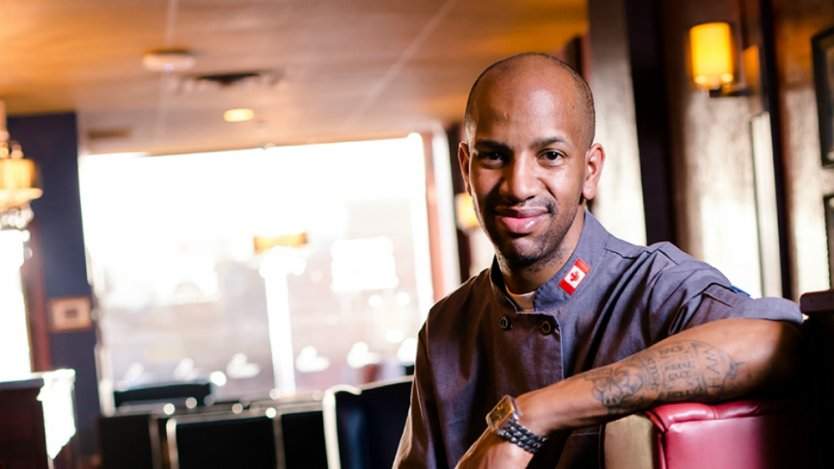Transitioning from life as the executive chef of Swan’s in Inglewood, a local institution, to feeding hundreds of hungry CP Rail employees for two of the three meals in the day has been a change of pace for Mike Provo--an increased pace that is. He shares some of the upsides and downsides of becoming a caterer, as well as how entering the business has challenged his preconceptions of what catering entails.
Why did you decide to transition into catering?
I wanted to see what else was out there. I worked in kitchens for 20 years. Catering on the other hand: some love it, some hate it. I thought the only way to know for sure was to try it myself. The flexibility and creativity you get to have are the two things I really like about catering. We don’t have a recipe book in our kitchen so you have to have a good skill set.
What has been the easiest part about making the switch? What has been the hardest part?
The easiest part is having ultimate creativity. I get to order whatever I want, make whatever I like, and challenge myself. On the other hand, it’s challenging because there are a lot of last minute things. You may get an email about an event someone wants to host the next day and you don’t say no. I also had to grow a thick skin. I’m not used to receiving criticism that bluntly. I’ve had people bring plates up to me and say, “I don’t like this.”
Did you have any preconceptions about what catering would be like? How have these been either confirmed or falsified based on your experience thus far?
In terms of things that have been falsified, I was under the impression that catering was mostly sandwiches, veggie platters, fruit platters, and those sorts of things. I didn’t realize it would be as high end as making something like homemade strawberry “Twizzlers”, which I did for an entirely raw food event.
As for what I was right about, I’ve been fortunate to work with a really skilled team. I’m surrounded by a lot of people that are pretty talented. Not having a recipe book to lean on really forces you to be there and engage in what you’re doing.
What misconceptions do you think people have about catering?
I think the general population thinks of it as soups, sandwiches, the office luncheon, which was my view on it too, at the beginning.
When it comes to other chefs, I don’t think a lot of people realize you can put out high quality food at a high price point.
How is catering different from cooking in restaurants for what you are able to prepare and prepare well? Have you found these limitations challenging?
I wouldn’t say there are restrictions. There’s a lot more thought on what goes out the door. Do you cook it on site or do you transport it? The process of how you get there is a lot more thought out. You have to think about travel time. How long will it take in rush hour traffic? Do we have enough space? Those sorts of things are logistics you don’t have to deal with in restaurants.
What do you miss most about working in restaurant kitchens?
I miss the rush, when it’s Friday night, 6 p.m., and you have a full house waiting for food. Catering is like a never ending rush.
What has been the craziest catering request you’ve received so far?
We made lasagna for 700 people in Drumheller. It worked out to 74 hotel pans, which doesn’t seem like a lot but it got pretty monotonous. Recently, we did a Stampede breakfast for 5,000 people and made over 17,000 pancakes. Actually I would say the mass ones are easier to execute. When you do smaller events in peoples’ homes, you don’t know what you’re going to get, what the set up is going to be, if you can use their pots and pans or if you have to bring your own. It’s trial and error, though. With each one, you get better.
What has been the biggest issue you’ve had to overcome?
For one event, we had to make 14 different tapas and somehow we missed a $500 charcuterie board. I had to get my sous chef to run across town in rush hour traffic to get it. Thankfully, the customer didn’t notice, but I definitely learned to double check, triple check, even, and not take things for granted.
Where do you think catering is headed?
With the economy right now and how fine dining has died down in past decade, I think people will be more in tune with catering in their own home. You don’t have to dress up and head to fancy restaurants. We can supply wine, and do whatever you need, really, from appies on the patio to formal dinners with white table cloths. I think there will continue to be a focus on tapas, smaller bites, and the socializing aspect. People want to see familiar faces cooking food. I’ve already had repeat customers request that myself or my chefs come cater their events.
What advice do you have for someone who wants to get into catering, or make the switch from kitchens to catering?
Walk in with a very open mind. It’s challenging on some days and straight forward on other days. Nothing is set in stone. You don’t know what tomorrow will bring. It’s not as structured as a normal restaurant, but that’s also what allows for flexibility and creativity.













